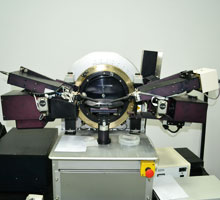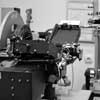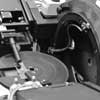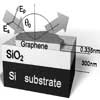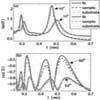The GES5E-IRSE Spectroscopic Ellipsometer is a combined system consisting of: DUV-Visible-NIR Spectroscopic ellipsometer (SE) and Fourier Transform Infra-Red Spectroscopic Ellipsometer (FTIR-SE). The polarizer and analyzer arms of both ellipsometers are mounted on a high resolution goniometric bench, made of double hollow crown. Both these crowns are driven by computer controlled stepper motors. The incidence angle can vary from 7 to 90° in DUV-Visible-NIR range, and from 20 to 90° in MIR range, with a theoretical resolution of 0.0005°.
The DUV-Visible-NIR Spectroscopic ellipsometer (SE) is working in a rotating polarizer configuration. It operates on the principle of mechanical modulation of the incidence light polarization by rotation of the polarizer at a constant angular frequency of 9 Hz. The analyzer remains in a fixed position, preparing the signal for the detector, insensitive to polarization. The precision of the ellipsometer for both weak and strong absorbing materials characterization is significantly enhanced with an automatically adjustable compensator. The light source is one 75 W Xe arc lamp, directly adapted to the polarizer arm. It emits a continuous spectrum of light, ranging from ultraviolet, trough visible to infrared (185-2000 nm). The light spot on the sample in parallel beam configuration is 1-10 mm2, depending on the aperture. There is also an additional miscrospot option for focusing the beam with a spot size of 365 x 270 μm, for an incidence angle of 75°. The light is introduced from the analyzer arm to the spectrometer using optical fiber making the light beam more stable. By combining the spectrometer with the photomultiplier tube (PMT) detector in UV-VIS range (190-900 nm), and InGaAs detector in NIR range (750-2000 nm), a high resolution spectrum is obtained by scanning the ellipsometric image at many discrete wavelengths. The spectrometer contains two dispersive elements (grating and prism) in collaboration with each other, separated by an intermediate fixed slit. The grating is blazed at optimum wavelength in order to obtain a maximum efficiency and the prism refracts the incoming wavelengths to act as a filter for higher order of diffraction produced by the grating.
The Fourier Transform Infra-Red Spectroscopic Ellipsometer (FTIR-SE) is a combination of a rotating analyzer configuration and a Fourier transform spectrometer. The basis of the FTIR spectrometer is a Michelson interferometer, which modulates each wavelength by a different frequency. The light leaving the Michelson interferometer enters the ellipsometer and successively passes the polarizer, the sample, the analyzer and finally hits the detector.
The light source for this IR ellipsometer is a silicon carbide (SiC) globar. Our system uses two different detectors: MCT in a range 580 cm-1 to 7000 cm-1, and DTGS in a range 385 cm-1 to 6500 cm-1. There is also an optional compensator in order to improve the accuracy of the measurements.



